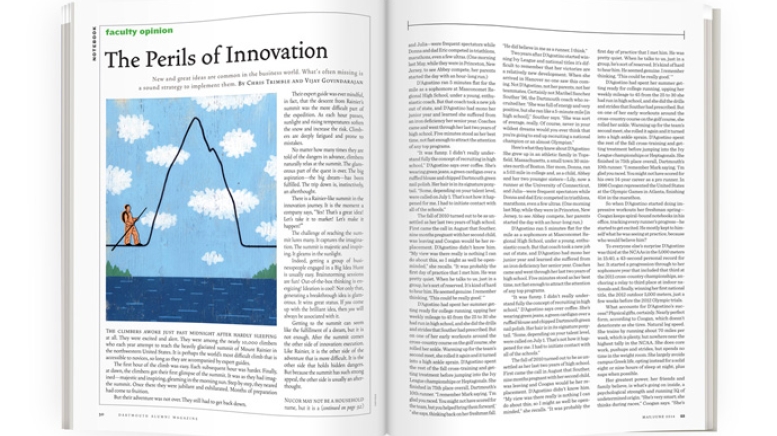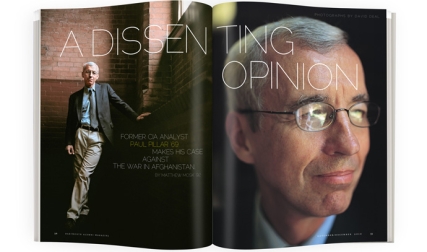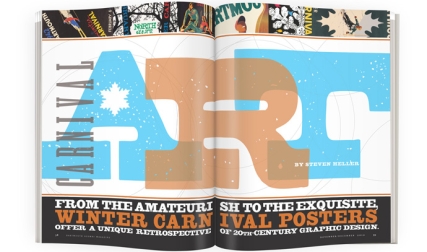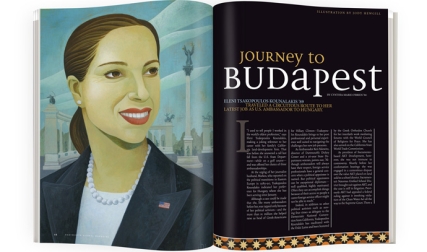The climbers awoke just past midnight after hardly sleeping at all. They were excited and alert. They were among the nearly 10,000 climbers who each year attempt to reach the heavily glaciated summit of Mount Rainier in the northwestern United States. It is perhaps the world’s most difficult climb that is accessible to novices, so long as they are accompanied by expert guides.
The first hour of the climb was easy. Each subsequent hour was harder. Finally, at dawn, the climbers got their first glimpse of the summit. It was as they had imagined—majestic and inspiring, gleaming in the morning sun. Step by step, they neared the summit. Once there they were jubilant and exhilarated. Months of preparation had come to fruition.
But their adventure was not over. They still had to get back down.
Their expert guide was ever mindful, in fact, that the descent from Rainier’s summit was the more difficult part of the expedition. As each hour passes, sunlight and rising temperatures soften the snow and increase the risk. Climbers are deeply fatigued and prone to mistakes.
No matter how many times they are told of the dangers in advance, climbers naturally relax at the summit. The glamorous part of the quest is over. The big aspiration—the big dream—has been fulfilled. The trip down is, instinctively, an afterthought.
There is a Rainier-like summit in the innovation journey. It is the moment a company says, “Yes! That’s a great idea! Let’s take it to market! Let’s make it happen!”
The challenge of reaching the summit lures many. It captures the imagination. The summit is majestic and inspiring. It gleams in the sunlight.
Indeed, getting a group of businesspeople engaged in a Big Idea Hunt is usually easy. Brainstorming sessions are fun! Out-of-the-box thinking is energizing! Ideation is cool! Not only that, generating a breakthrough idea is glamorous. It wins great status. If you come up with the brilliant idea, then you will always be associated with it.
Getting to the summit can seem like the fulfillment of a dream, but it is not enough. After the summit comes the other side of innovation: execution. Like Rainier, it is the other side of the adventure that is more difficult. It is the other side that holds hidden dangers. But because the summit has such strong appeal, the other side is usually an afterthought.
Nucor may not be a household name, but it is a remarkable company that unleashed the power of innovation in a decaying industry. Nucor makes steel. The company was of inconsequential size in 1970 but grew at an average of 17 percent per year to more than $4 billion in revenues by 2000 while returning 20 percent on equity. During the same time the U.S. steel industry struggled as it wrangled with competition from abroad, threats from alternative materials and strained labor relations. In fact, the industry delivered one of the worst profitability and growth records in the economy.
Nucor’s success cannot be attributed to a breathtaking strategy. Its strategy was plain and simple: Operate efficiently and compete on costs. Nucor could succeed only by innovating every day.
The company’s model for innovation was not mysterious. It galvanized the energy and ingenuity of its workforce. The company did so with two essential policies:
• To stimulate ideas, Nucor cross-trained its employees and rotated them among plants.
• To motivate each employee to find innovative ways for improving production efficiencies, Nucor paid for results. Base salaries were actually low for the industry, but bonuses ranged from 80 to 150 percent of base wage. Those bonuses were paid weekly based on the number of tons of steel produced that met quality standards.
Thus Nucor’s model for innovation can be reduced to a simple equation: innovation=ideas+motivation.
This combination created an environment in which innovation happened as close to the front lines as possible. When employees saw a way to improve performance, they took the initiative to make it happen.
However, as powerful as this approach can be, and as potent as it proved for Nucor, consider that this model for innovation has limitations. What if pursuit of a particular innovation initiative requires more than the small sliver of free time that individual employees have after fulfilling their day-to-day responsibilities?
Imagine that you work on the factory floor at Nucor and you have a big idea for improvement; maybe it is a major reconfiguration of materials flow through the steel mill. Even if it is a powerful idea, it is far beyond your ability to pursue while on the job. You might try to gather some friends to contribute their energies, but even if you are very persuasive, the total resources available to you are tiny—a handful of employees and their spare time. Any project requiring more resources than that withers.
As Nucor’s experience shows, thousands of small steps can add up to a powerful result. Still, larger innovation initiatives require a different approach.
One of Deere & Co.’s most important product lines is world-class tractors for large-scale agriculture. These are complex machines. Hundreds of people are involved in designing and bringing each to market. It takes about four years and $100 million to design just one.
A company as well managed as Deere brings as much discipline to the task as possible. In fact, the company treats product development much like any other business process. It tries to make it efficient and reliable.
Indeed, through many years Deere & Co. has gone to great lengths to perfect its recipe for developing new tractors. Documentation of the process constitutes, literally, several weeks of reading. As a result everyone on the product development team understands his or her role. Each person understands that he or she is accountable for completing each step in the design process on time and on budget.
Deere & Co.’s capability to quickly and efficiently launch new tractors with cutting-edge technology is impressive. At a high level, its approach to innovation is shared by many companies. It can be reduced to a simple equation: innovation=ideas+process.
The execution challenge is reduced to creating a step-by-step process that can be used again and again.
However, any formulaic process for innovation is also a narrow and specialized capability. It relies on each new product being mostly similar to previous-generation products. Make design changes that are too significant and any well-oiled innovation process stumbles. A more robust model for execution becomes necessary.
The innovation=ideas+motiva-tion formula can generate thousands of small initiatives but does not support projects requiring resources beyond a few people and their spare time. The innovation=ideas+process model can efficiently crank out innovation after innovation, as long as each initiative is mostly a repeat of prior efforts.
But in a fast-changing world innovation beyond the limits of these two models is critical. In 2007 IBM ran an advertisement intended to convey that it could help its clients innovate. It featured a pudgy mock superhero sporting a capital “I” on his outfit who introduced himself as “Innovation Man.” A bemused colleague asked, “And your job is?” The superhero responded with gusto, “I for ideation! I for invigoration! I for incubation!” The onlooker replied, “What about I for implementation?” Innovation Man answered, “I knew I forgot something.”
It captured so humorously and yet so perfectly the off-balance approach to innovation that is commonplace in corporations around the world. There is too much emphasis on ideas, not nearly enough emphasis on execution. Thomas Edison made essentially the same observation more than a century ago: “Genius is 1 percent inspiration, 99 percent perspiration.”
Nobody listened.
Several companies have shared with us their maps of the innovation process. These maps are revealing. One typical diagram showed innovation as a four-stage process: generating ideas, refining ideas, selecting ideas and, finally, like a lazy afterthought, implementation.
No wonder, then, so many innovation initiatives hit a wall. The guiding managerial model for innovation is just too simple. It reduces to: innovation= ideas.
As a result most corporations have more ideas than they can possibly move forward. Far too many promising ideas on paper never become anything more than that.
Here is an improved equation for innovation: innovation=ideas+execution.
Can the U.S. auto industry reinvent itself? Not without a range of innovative new products. Can the health-care industry find a way to deliver access and quality and keep costs under control? Not without commercializing entirely new approaches. Can the global energy industry create a future far less dependent on fossil fuels? Not without breakthrough victories in renewables.
There is no shortage of great ideas on how to address these major challenges, but implementation will be at the heart of meeting them successfully. The critical questions are: What did we learn from innovation failures of the past? Are we better prepared to convert great ideas into great impact? Are we ready for the other side of innovation?
Chris Trimble and Vijay Govindarajan are on the faculty at the Tuck School of Business. This article is excerpted from The Other Side of Innovation: Solving the Execution Challenge (Harvard Business School Press, 2010). Copyright 2010 Vijay Govindarajan and Chris Trimble; all rights reserved.




